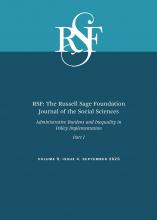Research Article
Open Access
Administrative Burden in Federal Student Loan Repayment, and Socially Stratified Access to Income-Driven Repayment Plans
Adam Goldstein, Charlie Eaton, Amber Villalobos, Parijat Chakrabarti, Jeremy Cohen, Katie Donnelly
RSF: The Russell Sage Foundation Journal of the Social Sciences September 2023, 9 (4) 86-111; DOI: https://doi.org/10.7758/RSF.2023.9.4.04
Adam Goldstein
aAssociate professor of sociology and public affairs at Princeton University, United States
Charlie Eaton
bAssociate professor of sociology at University of California Merced, United States
Amber Villalobos
cPostdoctoral research associate at the Higher Education, Race, and the Economy Lab at University of California Merced, United States
Parijat Chakrabarti
dPostdoctoral fellow at the University of Michigan, United States
Jeremy Cohen
eDoctorate in sociology from Princeton University, United States
Katie Donnelly
fDoctoral candidate in sociology at Princeton University, United States

REFERENCES
- ↵
- AccessLex
- ↵
- Baum, Sandy, and
- Matthew Chingos
- ↵
- Bhargava, Saurabh, and
- Dayanand Manoli
- ↵
- Brodkin, Evelyn Z., and
- Malay Majmundar
- ↵
- Cherlin, Andrew J.,
- Karen Bogen,
- James M. Quane, and
- Linda Burton
- ↵
- Christensen, Julian,
- Lene Aarøe,
- Martin Baekgaard,
- Pamela Herd, and
- Donald P. Moynihan
- ↵
- Collier, Daniel,
- Dan Fitzpatrick, and
- Christopher Marsicano
- ↵
- Conkling, Thomas S., and
- Christa Gibbs
- ↵
- Consumer Data Industry Association
- ↵
- Consumer Financial Protection Bureau
- ↵
- Consumer Financial Protection Bureau
- ↵
- Darolia, Rajeev, and
- Andrew Sullivan
- ↵
- Delisle, Jason D., and
- Lexi West
- ↵
- Dudley, Kristin,
- Samuel Austin Caperton,
- Nichole Smith Ritchie, and
- David Richards
- ↵
- Frotman, Seth, and
- Sarah Gibbs
- ↵
- Goldstein, Adam, and
- James Frank Wharam
- ↵
- ↵
- Haughwout, Andrew F.,
- Donghoon Lee,
- Joelle Scally, and
- Wilbert Van der Klaauw
- ↵
- Herd, Pamela, and
- Donald P. Moynihan
- ↵
- Houle, Jason, and
- Fenaba Addo
- ↵
- Karamcheva, Nadia,
- Jeffrey Perry, and
- Constantine Yannelis
- ↵
- Kopparam, Rasha, and
- Austin Clemens
- ↵
- ↵
- Lewis, Kevin M., and
- Nicole Vanatko
- ↵
- Moss, Jennifer L.,
- Norman J. Johnson,
- Mandy Yu,
- Sean F. Altekruse, and
- Kathleen A. Cronin
- ↵
- ↵
- Mueller, Holger M., and
- Constantine Yannelis
- ↵
- OECD
- ↵
- Pearl, Joanna
- ↵
- Peeters, Rik
- ↵
- Postsecondary National Policy Institute
- ↵
- Quinn, Sarah
- ↵
- Raval, Devesh
- ↵
- Ray, Victor,
- Pamela Herd, and
- Donald Moynihan
- Salganik, Matthew J
- ↵
- Schanzenbach, Diane W
- ↵
- Soobader, Mah-jabeen,
- Felicia B. LeClere,
- Wilbur Hadden, and
- Brooke Maury
- ↵
- Soss, Joe,
- Richard C. Fording, and
- Sanford F. Schram
- ↵
- Student Borrower Protection Center and American Federation of Teachers
- ↵
- Sunstein, Cass R
- ↵
- University of California Consumer Credit Panel Data
- U.S. Department of Education
- ↵
- U.S. Government Accountability Office (GAO)
- ↵
- U.S. Federal Reserve Board of Governors
- ↵
- Weir, Margaret, and
- Jessica Schirmer
- ↵
- Wu, Derek, and
- Bruce Meyer
- ↵
- Young, Cristobal, and
- Xinxiang Chen
In this issue
Administrative Burden in Federal Student Loan Repayment, and Socially Stratified Access to Income-Driven Repayment Plans
Adam Goldstein, Charlie Eaton, Amber Villalobos, Parijat Chakrabarti, Jeremy Cohen, Katie Donnelly
RSF: The Russell Sage Foundation Journal of the Social Sciences Sep 2023, 9 (4) 86-111; DOI: 10.7758/RSF.2023.9.4.04
Administrative Burden in Federal Student Loan Repayment, and Socially Stratified Access to Income-Driven Repayment Plans
Adam Goldstein, Charlie Eaton, Amber Villalobos, Parijat Chakrabarti, Jeremy Cohen, Katie Donnelly
RSF: The Russell Sage Foundation Journal of the Social Sciences Sep 2023, 9 (4) 86-111; DOI: 10.7758/RSF.2023.9.4.04
Jump to section
- Article
- Abstract
- FEDERAL STUDENT LOAN SERVICING AND REPAYMENT PROGRAMS
- FEDERAL STUDENT LOAN SERVICING
- ADMINISTRATIVE BURDEN AND SOCIAL STRATIFICATION
- BURDENS AND STRATIFIED ACCESS TO PUBLIC PROGRAMS
- METHODS AND RESEARCH DESIGN
- QUALITATIVE DATA AND METHODS
- QUANTITATIVE DATA AND METHODS
- QUALITATIVE ANALYSIS OF CFPB COMPLAINTS
- IMPLICATIONS FOR ADMINISTRATIVE EXCLUSION FROM IDR
- COMBINED EFFECTS OF ADMINISTRATIVE BURDENS ON STRATIFIED ACCESS TO REPAYMENT PLANS
- DISCUSSION AND CONCLUSION
- BROADER IMPLICATIONS
- APPENDIX. DESCRIPTION OF CODING SCHEME FOR QUALITATIVE ANALYSIS
- FOOTNOTES
- REFERENCES
- Figures & Data
- Info & Metrics
- References
Related Articles
- No related articles found.
Cited By...
- No citing articles found.





